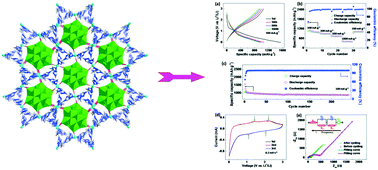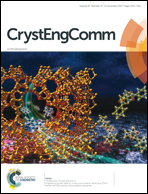A novel 3D POMOF based on Wells–Dawson arsenomolybdates with excellent photocatalytic and lithium-ion battery performance†
Abstract
Herein, a novel POMOF based on Wells–Dawson arsenomolybdate (AM), with the formula [{Cu(btp)2}3{As2Mo18O62}] (btp = 1,3-bis(1,2,4-triazol-1-yl)propane) (1), was synthesized under hydrothermal conditions and structurally characterized by single crystal X-ray diffraction, elemental analysis, IR spectroscopy, XPS, PXRD, TG analysis, UV-vis-NIR spectroscopy, and BET analysis. It is interesting that the [As2Mo18O62]6− polyoxoanion as a hexa-connector is encapsulated with {Cu-btp} complexes to form a 3D POMOF. The 3D topological network has the Schläfli symbol of {46·55·62·72}3{46·56·73}. Compound 1 shows excellent stability in air, different pH aqueous solutions and common organic solvents. Compound 1 also exhibits fluorescence properties and efficient and stable photocatalytic activity for the degradation of MB and RhB under UV irradiation. In addition, the electrochemical performance of the designed Wells–Dawson AM as the anode material for lithium-ion batteries (LIBs) has also been evaluated. For the 1st cycle, the reversible capacity of compound 1 is about 1050 mA h g−1 at a current density of 100 mA g−1 and is maintained at around 870 mA h g−1 after 240 cycles.



 Please wait while we load your content...
Please wait while we load your content...